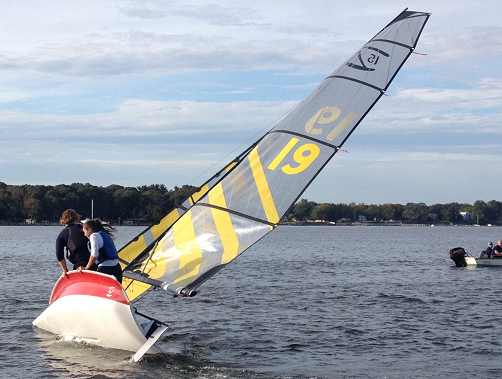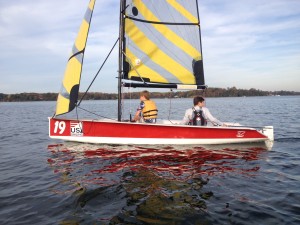Thanks to an increased recognition for the quality and performance of our boats, Whitecap Composites has had a busy 2014. We refined our already-unique Turbo 420, 
Whitecap’s new 1-for-10 program aims to give more kids access to our newest designs. From now until April 1, if you order ten boats we will be donating one boat to a sailing program of your choice. There has never been a better time to help boost your local sailing program and encourage kids to get back on the water this summer!
To learn more, contact Whitecap Composites today!
Blog
El Toro
Although the El Toro was conceived in “Bull Sessions” at the Richmond Yacht Club in 1936, it has become a recognized class of over 11,000 one-design yachts and is the most popular “dinghy” on San Francisco Bay.

Junior sailing programs at yacht clubs and municipal sailing classes have developed many fine young El Toro captains. High quality racing programs have kept the interest of these young sailors. Often sailors “move up” to larger yachts and are frequently recognized as champions. Many return to the lively tactical sailing situations provided by El Toro racing.
The El Toro has benefited by high quality racing provided by the Small Boat Racing Association. The SBRA has in turn been supplied with sailors in many other classes that have started in the El Toro.
| Length: | 7 ft. 11 in. | Sail Area: | 49 sq. ft. |
| Beam: | 3 ft. 10 in. | Hull: | Wood or Fiberglass |
| Weight: | 60 lbs. (hull only) | Spars: | Wood, Aluminum, or Carbon Fibre |
| 80 lbs. (min. wt. Equipped) | Crew: | One |
-From the El Toro class website
Beetle Cat
The Beetle Cat boat is a 12 foot, gaff rigged, wooden sailboat first built in 1921 by the Beetle family of New Bedford, Massachusetts. Beetle, Inc., now located in Wareham, Massachusetts, is now the sole builder of Beetle Cat boats.

We hope these pages will be a resource and an inspiration to anyone interested in Beetle Cat boats and traditional wooden boat building.
Bill Womack, Owner/Manager – from the Beetle Cat Website
NE Beetle Cat Association: http://www.beetlecat.org/
Life After College: Sailing the Z15
By Airwaves writer Tyler Colvin
The past couple decades has seen rapid growth in the numbers of athletes participating in college sailing. In that time the level of sailing has increased exponentially. It could be argued that ICSA Team Race Nationals is the most competitive event in North America on an annual basis. The numbers of high-level post-graduate sailors has increased accordingly. Several boats have arisen to fill the need for a competitive dinghy, such as the V15, however none have had any kind of permanent lasting power. Enter the Z15, the new post-collegiate performance dinghy in the US market from Zim Sailing. A technical boat with advanced rig and hull design characteristics, the Z15 looks to fill a gaping hole in the lives of recent graduates.
The Boat: Technically Sound
Not content with simply remaking the wheel and redesigning existing boats, Zim looked to veteran dinghy builder Steve Clark for inspiration using modern technology and hull designs. At 14’9” long with a beam of 5’5”, the Z15 is slightly longer and wider than an FJ while trimming over 30lbs for a hull weight of 180lbs thanks to the fully cored resin infused construction process.
The rig is an update on traditional construction as well. A fully carbon, tapered rig from Southern Spars is fully adjustable and provides a healthy amount of power and eliminating the need for a third (spinnaker/gennaker) sail off the wind. Designed with a wide range of weights and skill levels in mind, the rig is easily depowered for breezy conditions.
Set Up and Sailing: Quick
Thomas Sitzmann, head coach of the Severn School sailing team and previously of Bowdoin College has brought the Z15 to high school sailing in Maryland. On the Z15, “It’s not the same old thing. It can out-sail most dinghies in 3-4 knots, and will definitely perform well in more wind. So, I’d say I enjoy the fact that it is bringing innovation, change, and more options to our sailing world.” Light, fast and technical the Z15 provides new challenges for sailors used to the traditional double-handed designs.
Upwind the boat is sensitive with a narrow groove. “It’s tippy,” said Sitzmann, “and in my brief time sailing it, it seems to be very finicky…In a way, that’s what may be best about the boat. It will force sailors to learn more about sail controls, trim, and balance.” A light air beast, the Z15 was put on display this past fall at the Hinman Trophy US Team Race Championships. Athletes described the boat as sensitive and very responsive to weight placement and sail trim.
Downwind the Z15 takes some adjustment. The lack of a big off-wind sail means the introduction of a whisker-pole to get the clew of the jib out and drawing. The ability to wing the jib out further than held by hand means deeper angles can be sailed than what a two-sail boat might normally be able to achieve. The hull shape makes weight placement key and thusly much less roll is needed to boat-handle than an FJ or 420.
Why Sail? New and Improved
Most of today’s double-handed boats were designed over half a century ago. While they are still more than capable and serve a very large purpose in the youth and collegiate sailing community, there is a need for a technical dinghy for high-level fleet and team racing. It continues to evolve as feedback comes back from the racecourse and promises to be a competitive class for years to come. Mentioned before, it was featured in the Hinman Trophy this past fall and will be the boat of choice for the new 2015 Team Race Midwinters (replacing V15 Midwinters).
Whether you are stepping out of collegiate dinghies, or simply looking for something new and exciting, the Z15 looks to be an exciting new platform for racing. With a price tag around $11,500, the Z15 is a more exciting, faster and most important, growing cousin of the V15. For the moment it would appear the Z15 is the best option for post-collegiate sailors and yacht club members looking for a fun, fast boat to team race in. Bottom line, the Z15 infuses new life into the young adult dinghy racing circuit and provides a new alternative in the performance market.
Coaches Locker Room: Regatta Planning For Your Sailors
Regatta Prep: Junior Sailing
Part 1: 1-2 Weeks Out
Preparation for an event, from your first green fleet regatta to gold fleet youth champs starts a week or two before you pack up the trailer and leave for the venue. Prepping both yourself and your players for a regatta makes your life easier and puts them in the best position to succeed.
The process starts anywhere from 4-6 practices out from the event depending on the preparation of your players. A practice schedule could look something like this:
- Day 1: Lock down boat handling, spinnaker work, making sure skippers and crews are on the same page in the boat.
- Day 2: Review of rules of the road and situations. Practice consists of short courses and trying to generate as much traffic as possible so that a small fleet can feel like a big one.
- Day 3: Review of basic strategy and tactical ideas. Try to run a handful of races in a similar length to the actual event. Most junior sailing events try to have about a 35-45 minute total race length and they need to adjust to a long beat, looking for breeze on the run, and more importantly knowing how much energy a long race requires.
- Day 4: Starts. Everything related to starts. Line sights, acceleration, time on distance, favored end, choosing an end, practicing holding a spot. All of this using the sequence, flags and line configuration that will be used in the regatta.
- Day 5/6: Review of the schedule for the weekend, sailing instructions for the regatta, make sure everyone is ready to sail before you get to the venue. Also today can involve packing up the boats for travel. Touching base with the parents involved needs to be an ongoing dialogue throughout the week.
This is a very general outline and can be adjusted as you see fit. Once you hit the full swing of summer where travel to events is every weekend this will be adjusted accordingly.
Your own preparation will change accordingly as well, but in essence it has several essential parts.
- Know your travel plans. How are you getting to the venue, how is your coach boat getting there and where are you staying once you are there? Much of this (logistically) will be handled by your program director, but you and only you are responsible for making sure it all happens.
- Know the venue. If you’ve never sailed there or coached there, find someone who has and get some knowledge of the tides, wind tendencies, and weather.
- Know the weather. Check and double check as the week goes on, as it will probably change. In New England it changes on an hourly basis with little warning. This goes for wind as well, there are several good iPhone wind apps you can download.
- Get a copy of the sailing instructions and download a copy to iBooks on your phone. Know the schedule, the flags being used, everything you need to know about the regatta.
- Pack your bags. Typically an overnight bag and a regatta bag. Overnight bag is easy, change of clothes and sundries. Regatta bag is everything you need for a day on the water. Foul weather gear, sunglasses, hat, sunscreen, water, food, spare parts, electrical tape, duct tape, spare line, anything else you can think of as well.
The more you ready yourself, the better you will be able to coach your players. Preparing them for the event is as much about results as it is their own enjoyment. If they go into an event feeling unsure and overwhelmed, you can be sure that they will be stressed during competition. You know your players best, and addressing their concerns and weaknesses going into the event will be different group to group. Develop your own routine and each event will get progressively smoother.
Coming soon, packing a trailer, coaching an event and debriefing.
Feeling ready for summer yet? Check back here at the Locker Room for more articles helping you land your dream job and prepare for a summer on the water. As always, email me at [email protected] with questions, comments, or ideas for articles.
Coaches Locker Room: Junior Sailing Coaching 101
Congratulations on landing your first summer coaching job. Life as a coach is different from as a sailor, more responsibility and more freedom. Making the most of your summer is all about managing your responsibilities so you can capitalize on your freedoms. Between sailors and members there are plenty of responsibilities and pitfalls to be avoided. Here are some tips and tricks to a smooth summer.
Names, Ages, Numbers

Always, always know at least one of the three things above about your class, preferably all three. This is your first year, chances are you are a Beginning Opti coach and get to spend the next 10 weeks with a group of screaming 7-9 year olds.
It will be the best summer job you have ever had.
Learn everyone’s name. Most of us are not inclined to picking up names readily. Everyone, meaning literally everyone not just junior sailors, but other staff, members, afterguard, coast guard, the guy at the gas pump, learn as many names as you can. People like it when you call them by their name and are much more inclined to help you when you are inevitably in need.
Sailors respond to names. It is hard to tell the kid in the orange life jacket to do something if you aren’t directly addressing him or her. They all know your name; you need to know theirs as well. Name games are typically one of the least favorite things about the beginning of a summer, but after associating someone’s name with a piece of fruit over and over for ten minutes it is hard to forget. If you are still hard pressed to remember, a failsafe is a piece of duct tape on the back of the lifejacket with a name written in permanent marker.
Know the age group. What entertains an 8 year old will bore an 11 year old and have a 15-year-old turn his or her iPod to deafening. Pay attention to them and they in turn will pay attention to you. If you see a group starting to fade in an activity, switch activities before it has the chance to completely break down. Most kids already think you are pretty cool; you are older than a sibling but younger than their parents. By knowing your audience, what movies they like, the TV shows they watch, the YouTube videos they obsess over, you are much more likely to gain much needed respect and attention.
Numbers. This one is self-explanatory but is important nonetheless. Always know how many are in your class and if you currently can see that many heads. Just basic safety measures and by the end of the summer, making that headcount will be second nature. Numbers also matter for programming. Which drills you can do, duration of each one, timeline of the class, are all directly affected by how many kids you have on that given day. If you have a roster of 18 and only 10 show up, your chalk talk, rigging demonstration and tacking drill just got shortened and that is now space you need to fill some other way.
Yacht Club Life: Adjusting
Most people coaching junior sailing have some experience in the program. There are always exceptions to this rule, if a sailor learned after junior sailing age for instance, or if it is your first time at a new yacht club. Regardless of whether you were born on the balcony of the yacht club or this is your first summer in junior sailing ever, there are some adjustments to be made. You are now an employee, not a member (even if you are one of those too) and everyone knows who you are and what you are doing or have done. Make good decisions.
Game Plan: Have One
Planning your day/week/session in detail will help you when you show up two minutes before the morning meeting on six hours of sleep and no coffee in sight. It happens. Planning will also keep your director happy, give your kids a clear path for learning and allow you to involve fun events. Your lesson plan doesn’t have to be a three page detailed document, but jotting down six hours of drills for a four hour time slot will allow you to change gears quickly.
Programming for your summer will help your weeks flow and provide focus for your lesson plans. Think about where you would like your class to be at the end of the summer and plan backwards from there. Spending the time to do this at the beginning of the summer will save hours of headache at the end when you are at a loss for what to do with your class.
Big Picture: Enjoy Yourself
The most important of any summer spent on the water is to remember to have fun. What made your years in junior sailing fun? At the same time, how can we construct lesson plans that are constructive and fun? This all pertains to the first point of knowing the group you’re coaching. Everyone gets burned out by the end of the season, its inevitable. Recognizing that coming on and adjusting accordingly so that you stay fresh is the key to finishing a summer strong.
Get to know your coworkers. Growing the trust and comfort level will help you survive the summer. Go to the movies, get dinner, race together, do something as a team, whatever it takes. Some of them will become life long friends; some will only be summer acquaintances, but spending large amounts of time with them is unavoidable.
You have the best summer job possible. Don’t forget that.









